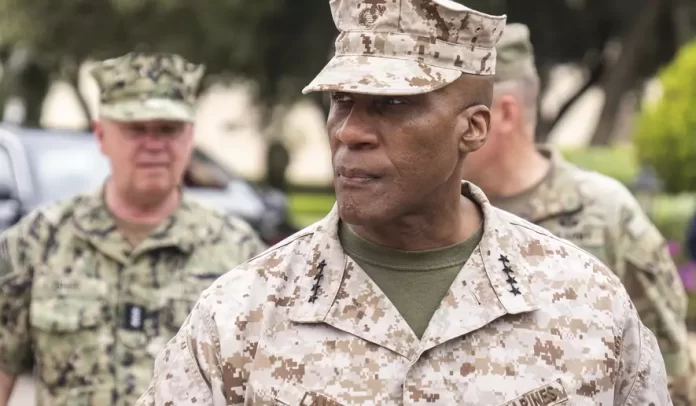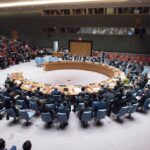PENTAGON — Islamic State in Somalia has approximately doubled in size over the past year, the chief of U.S. Africa Command told VOA.
“I am concerned about the northern part of Somalia and ISIS growing in numbers,” AFRICOM commander Gen. Michael Langley said in an exclusive interview, using an acronym for the terror group.
Langley declined to provide the United States’ estimate of how many Islamic State fighters are in Somalia, other than to say that the group’s had grown about “twofold” in the past year. Previous estimates have put the number of Islamic State fighters in north Somalia at about 200 fighters.
The AFRICOM commander also warned about the possibility of Islamic State increasing its foreign fighter presence in Somalia.
Somali Brigadier General Abdi Hassan Hussein, the former intelligence and police commander of Puntland, where Islamic State is located in the north, told VOA earlier this year that the number of Islamic State foreign fighters there alone is estimated in the hundreds. This figure has yet to be confirmed by local authorities.
A U.S. official told VOA in June that Abdulqadir Mumin, the leader of Islamic State in Somalia, had been targeted in an American airstrike in May. Mumin appears to have survived the strike.
Asked whether Mumin was now the global leader of IS, Langley said the U.S. must take those reports as “credible.”
“ISIS professes that. Sometimes you’ve got to take that seriously,” he said.
Al-Shabab
The increase in Islamic State fighters in northern Somalia comes as the al-Qaida affiliate al-Shabab has exploited diplomatic disagreements between Somalia and Ethiopia to raise its recruitment numbers.
Landlocked Ethiopia and Somalia’s breakaway Somaliland region signed a memorandum of understanding earlier this year to use its Red Sea port of Berbera, a deal that Somalia has rejected. Somali Prime Minister Hamza Abdi Barre on Friday accused Ethiopia, before the U.N. General Assembly, of actions that “flagrantly violate” Somalia’s territorial integrity.
“The have used that (dispute) to their advantage,” Langley told VOA.
Al-Shabab has been back at high numbers of between 12,000 to 13,000 fighters due to strong financing and heavy recruitment efforts, senior defense officials told VOA in June.
The political rift has bled into counter-terror cooperation between Addis Ababa and Mogadishu, with Langley telling VOA that Somali operations with Ethiopia have been “limited.”
“Time will tell if they can settle their differences and coalesce into a force that’s very effective, because when they do work together, they’re very, very effective at clearing out al-Shabab.’’
Al-Shabab has continued attacks on civilians, including in the Mogadishu area. The terror group claimed responsibility for a gun attack and suicide bombing that killed at least 32 people in August on a popular beach in the Somalia’s capital. The group is also suspected to have carried out two deadly bombings on Saturday, one in Middle Shabelle region and another about one kilometer from the president’s office.
Al-Shabab has suffered defeats from the South West State of Somalia down to the Juba River Valley and has sought to reset and counter-attack in those areas.
However, in central Somalia, al-Shabab has reversed gains made by Somali forces over the last two years as government forces failed to hold the terrain they had retaken, according to senior U.S. defense officials.
“We need a credible holding force, because sometimes shadow governments of al-Shabaab try to re-insert themselves back in that region and try to influence some of the local leaders,” Langley said.
He said the time following the clearing and liberating of a region is a “very fragile period” where Somalia and partners like the U.S. Agency for International Development can initiate local services that will increase the population’s faith in the federal government.
“If they can’t sustain that because they’re moving to the next region or next district, it ebbs,” he said, adding that U.S. training was currently focused on helping Somali forces hold liberated terrain.
The Somali government has pointed to the El Dheer and Harardhere areas as evidence that some liberated terrain in central Somalia remains under government control.
ATMIS transition
Later this year, the African Union Transition Mission in Somalia will leave the country after nearly two years of helping Somalia fight al-Shabab terrorists and will be replaced in 2025 by a new African Union Support and Stabilization Mission in Somalia. Which forces will be comprised in the mission is still being worked out by the African Union and the United Nations.
Langley ruled out any U.S. role in the transition, saying American forces would maintain only their advise-and-assist mission.
“Our piece of enabling is not our boots on the ground. We’re there to advise and assist, and assist in their training, but the fight is theirs,” he told VOA.
Houthis
In addition to Islamic State and al-Shabab, Somalia also must worry about Iranian-backed Houthi militants in Yemen, just north of Somalia across the Gulf of Aden, whom Langley says have “aspirations” to collaborate with al-Shabab.
“We’re concerned, and we’re closely watching that, because this can turn into a bad neighborhood real quick,” he said.
Should the Houthis and al-Shabab put pressure on the Gulf of Aden from opposite sides, Langley worries that squeezing this strategic choke point could further hinder the free flow of commerce and affect the global economy. And analysts fear that Houthis could insert more sophisticated weapons into the fight for Somalia.
Houthi militants have targeted more than 80 merchant vessels with missiles and drones since the war in Gaza started in October, seizing one, sinking two and killing at least four sailors. Other missiles and drones have either been intercepted by a U.S.-led coalition in the Red Sea or failed to reach their targets.
The Houthi militant campaign began after Israel launched a retaliatory attack against Hamas in Gaza following Hamas’ October 7 terror attack, and the Houthis claim they are acting in solidarity with Palestinians during the war.
Source: VOA






